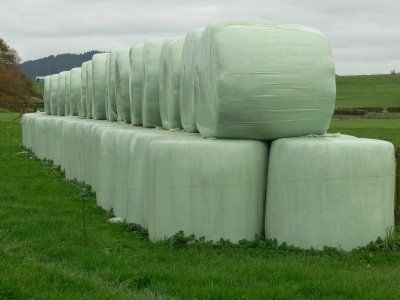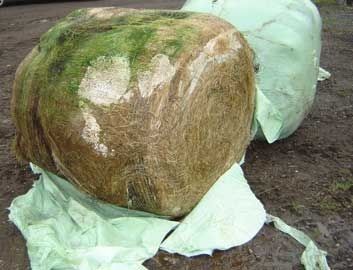Simple things you can do to avoid mould spoilage of wrapped haylage and silage.
by Roger Martyn
Plastic wrapped square or round baled silage or haylage will always present a greater risk to the farmer from spoilage than will pit silage. This is simply due to the greater potential surface area a wrapped bale presents to air. By contrast, a covered silage pit has only the top surface exposed.wrapped silage fenced off
It is also much more difficult to get good compaction in a bale compared to a pit situation, no matter how good the baling machinery. Good compaction ensures more air is expelled from which spoilage moulds will feed.

However moulds need not be a problem if they don't gain a foot-hold in the first instance.
Moulds (fungi) go through a life cycle, from which spores 'germinate' and moulds form. The spores are always present in pastures and are just waiting for the 'right' conditions to germinate. In general, warm wet conditions over just a short period of time (a couple of days)is often all it takes for spores to germinate and mould to develop.
Once mould has a foothold in a hay or silage crop, it is very difficult to stop the its development once the crop has been cut and committed to harvest. In these circumstances all the cut pasture material needs to be thoroughly dried and have sunshine on it to arrest the problem. More to the point, in practice it is very difficult to get every last bit of cut pasture exposed in this manner, as the pasture material needs to be thoroughly turned and dried and even then the odds are that some mould will survive only to multiply up and cause problems in the wrapped bale during storage.
Black 'mould' tends to occur where excessive moisture and air is present and the plant material becomes 'composted'.
White mould also requires air and moisture but in a baled silage situation, since it is impossible to expel all air present you will be stuck with it.

The only preventative solution to a situation where the weather has conspired against you and you are caught with potentially mouldy silage or haylage is to incorporate a mould inhibitor prior to baling. There are any amount of proprietary products on the market that merchants will be only too happy to sell you. If however the weather conditions leading up to and including harvest were ideal, there addition of mould inhibitors is likely to be an unnecessary expense.
Heavy rates of nitrogen fertilisers applied to boost silage crop yields can make them significantly more susceptible to mould development as can dirt contamination due to mower blades and harvesting tines being set too low.
It very important to ensure that once a bale is wrapped, that every care is taken not to penetrate it again as a penetration point can allow a gallery for air to circulate and moulds to multiply. That means no use of tractor mounted fork spears! Farmers have lost whole crops like this, even though the holes were covered up with tape. Unfortunately, we don't tend to hear of such losses making it difficult to learn from others mistakes.
When storing bales, it is quite OK to store them outside as the wrapping makes them waterproof and airtight. That this situation continues however is very dependent on site selection and protection of the site. The site should be well clear of potential surface flood water courses and areas of high stock traffic. The ground surface the bales rest on must be free of sharp objects. Avoid stacking bales under trees. Falling limbs and even very small branches can penetrate the plastic and cause spoilage. Ensure the site is well fenced off from any access to animals including inquisitive young stock.
Losses due to penetration of the plastic from bird attack has been known to occur. Covering bales with fine bird netting is one solution.
It is also a very good idea to lay rhodent bait around the stacks and replenish the baits on a three weekly cycle since losses from mice and rats can be horrific.

Regular inspection and taping over of any tears or holes in the plastic should be done at the same time. Remember too the longer you have it stored, the more likely something might damage the plastic causing spoilage to occur so where ever possible, feed the product out within at least a 12 month maximum period.

